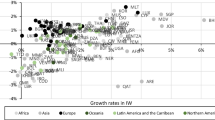Abstract
The sustainability of development is closely linked to changes intotal per capita wealth. This paper presents estimates of the wealth of nations for nearly 100 countries, broken down into produced assets, natural resources and human resources. While thelatter is the dominant form of wealth in virtually all countries,in low income natural resource exporters the share of natural resources in total wealth is equal to the share of produced assets. For low income countries in general, cropland forms thevast majority of natural wealth. The analysis suggests the process of development can be viewed as one of portfolio management: sustainable development entails saving the rents fromexhaustible resources, managing renewable resources sustainably,and investing savings in both produced assets and human resources.
Similar content being viewed by others
References
Atkinson, G., Dubourg, R., Hamilton, K., Munasinghe, M., Pearce, D. W. and Young, C.: 1997, Measuring Sustainable Development: Macroeconomics and the Environment, Edward Elgar, Cheltenham.
Dasgupta, P. and Mäler, K.-G.: 2000, 'Net national product, wealth, and social well-being', Environ. Develop. Econ. 5(1–2), 69–93 (February and May 2000).
Hamilton, K.: 1994, 'Green adjustments to GDP', Resour. Policy 20(3), 155–168.
Hamilton, K. and Clemens, M.: 1999, 'Genuine savings rates in developing countries', World Bank Econ. Rev. 13(2), 333–356.
Lampietti, J. and Dixon, J. A.: 1995, To See the Forest for the Trees: A Guide to Non-Timber Forest Benefits, Environment Department Environmental Economics Paper No. 13, Washington DC.
Pearce, D. W. and Atkinson, G.: 1993, 'Capital theory and the measurement of sustainable development: An indicator of weak sustainability', Ecolog. Econ. 8, 103–108.
Repetto, R., McGrath, W., Wells, M., Beer, C. and Rossini, F.: 1989, Wasting Assets: Natural Resources in the National Accounts, World Resources Institute, Washington, DC.
Sachs, J. D. and Warner, A. M.: 1996, Natural Resource Abundance and Economic Growth, Development Discussion Paper 517a, Harvard Institute for International Development, Cambridge, Mass.
Serageldin, I.: 1996, Sustainability and the Wealth of Nations: First Steps in an Ongoing Journey, Environmentally Sustainable Development Studies and Monographs No. 5, World Bank, Washington DC.
Serageldin, I. and Steer, A.: 1994. 'Epilogue: Expanding the Capital Stock', in I. Serageldin and A. Steer (eds), Making Development-Sustainable: From Concepts to Action, Environmentally Sustainable Development Occasional Paper No. 2, World Bank, Washington DC.
Smith, Adam: 1776, An Inquiry into the Nature and Causes of the Wealth of Nations, University of Chicago Press, 1977, Chicago.
World Bank: 1995, Monitoring Environmental Progress: A Report on Work in Progress, Washington, DC.
World Bank: 1996, World Development Report 1996: From Plan to Market, Oxford University Press, New York.
World Bank: 1997, Expanding the Measure of Wealth: Indicators of Environmentally Sustainable Development, Environmentally Sustainable Development Studies and Monographs Series No. 17, Washington, DC.
Author information
Authors and Affiliations
Corresponding author
Rights and permissions
About this article
Cite this article
Hamilton, K., Dixon, J.A. Measuring the Wealth of Nations. Environ Monit Assess 86, 75–89 (2003). https://doi.org/10.1023/A:1024054602002
Issue Date:
DOI: https://doi.org/10.1023/A:1024054602002




